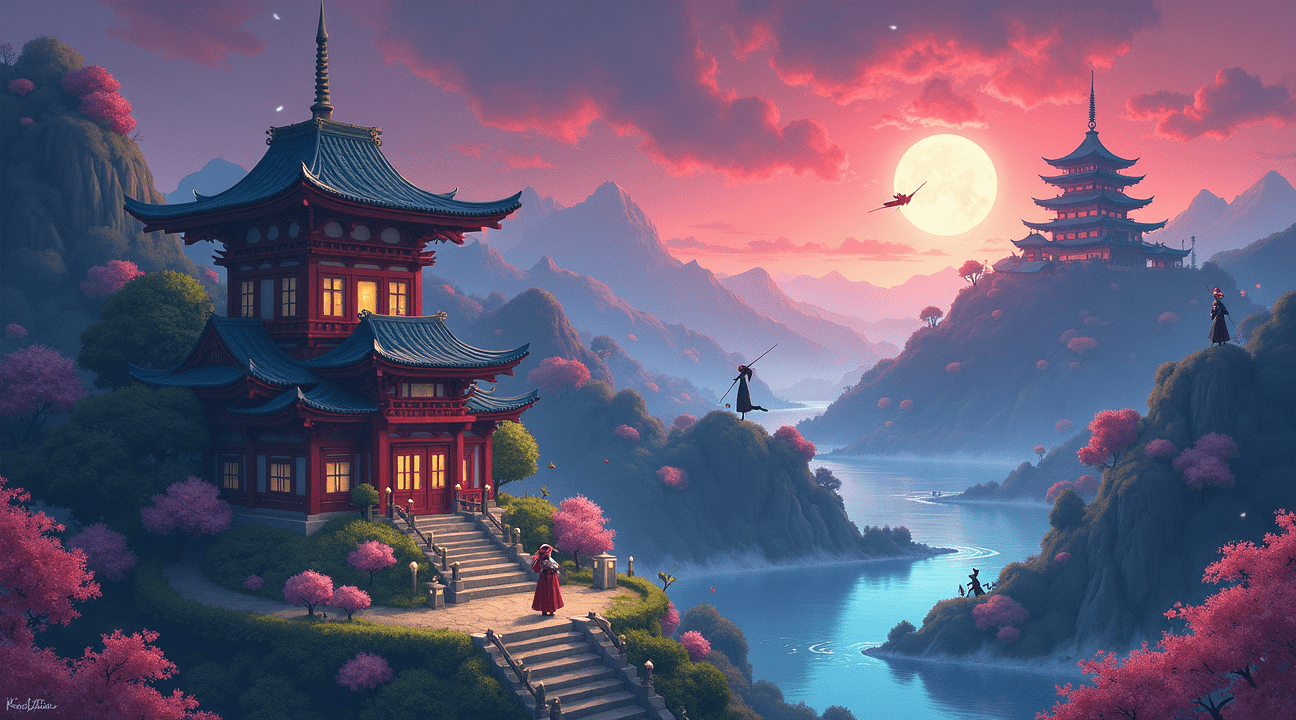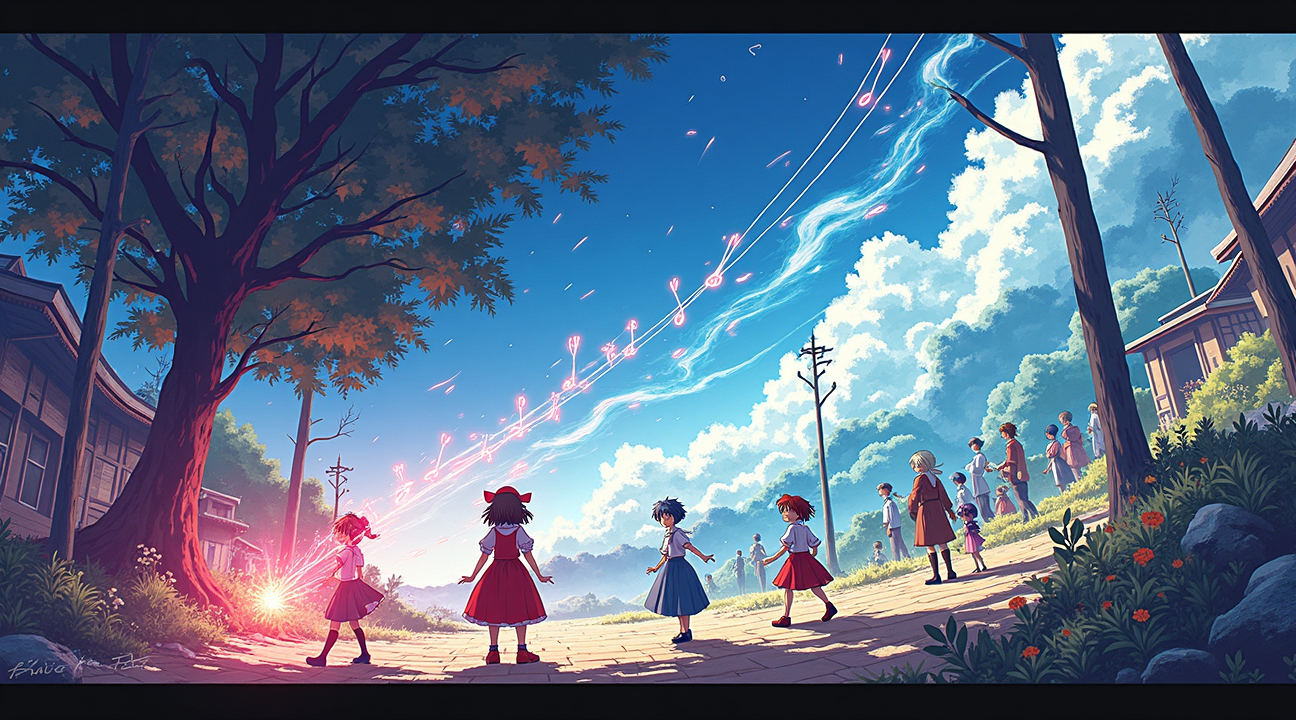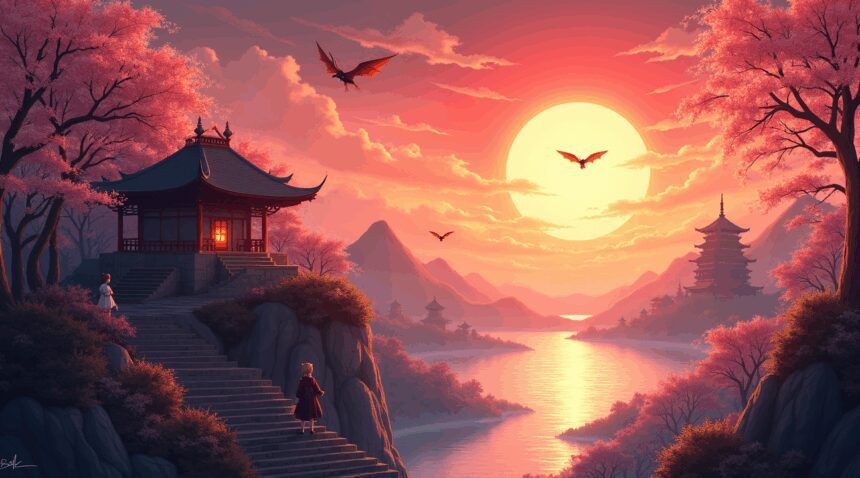The Touhou Project stands as an extraordinary independent gaming phenomenon that grew from a student project into a global cultural force, merging traditional Japanese folklore with innovative bullet hell gameplay mechanics.
Jun’ya ‘ZUN’ Ota created this masterpiece solely under Team Shanghai Alice, and this doujin series has generated an unparalleled fan community that produces everything from remixed music to elaborate merchandise. This authentic creative vision shows how originality can surpass traditional gaming boundaries.
Key Takeaways
- Gensokyo serves as a unique fictional sanctuary where humans and yokai coexist peacefully, separated from the modern world by the Great Hakurei Barrier and governed by rules established through the Yokai Expansion Project 500 years prior
- Danmaku gameplay combines artistic beauty with intense challenge through intricate bullet patterns, spell card systems, and mechanics like the Cherry Point gauge that reward precision and strategic thinking
- The series successfully transitioned from PC-98 origins to Windows platforms while maintaining ZUN’s complete creative control over programming, music composition, and world-building as a one-man development team
- Community-developed tools enhance the gaming experience through rotation utilities like Vertical Play and THRotator that optimize display settings for authentic arcade-style vertical gameplay
- Fan-created content has established Touhou as a cultural phenomenon spanning high-quality merchandise, musical remixes across multiple genres, visual art, doujinshi publications, and independent game development inspiration
For readers eager to explore the world of Touhou further, the fanbase maintains a rich archive of resources and updates, including the Touhou Wiki, where players and fans can dive into character lore, gameplay strategies, and developer insights from ZUN himself.
A Fantasy Realm Born from Bullets and Folklore: Welcome to Gensokyo
Gensokyo stands as a captivating fictional sanctuary hidden deep within the mountains of Japan, where reality bends to accommodate both the mundane and the magical. This secluded land operates under its own mysterious rules, completely separated from the outside world by the Great Hakurei Barrier—an mystical boundary that shields its inhabitants from modern interference.
A Land Where Humans and Yokai Coexist
The population of Gensokyo reads like a comprehensive guide to Japanese folklore come to life. Humans share their daily existence with supernatural beings called yokai, creating a delicate ecosystem where magicians practice their craft alongside spirits, vampires maintain their nocturnal schedules, and tengu soar through mountain passes.
Fairies dance through forests while oni demonstrate their legendary strength, and various gods oversee their respective domains with ancient wisdom.
This intricate balance wasn’t achieved overnight. The Yokai Expansion Project, which took place 500 years before the main game events, established the fundamental framework that allows such diverse beings to coexist peacefully. The project created the essential guidelines that prevent conflicts between species while maintaining each group’s unique characteristics and traditions.
Key Locations and Characters That Shape This Universe
The Hakurei Shrine serves as both a spiritual landmark and a crucial portal between dimensions. I find its dual nature particularly fascinating—it functions as a traditional place of worship while simultaneously acting as a gateway that maintains the barrier’s integrity.
Several remarkable characters define Gensokyo’s vibrant community:
- Reimu Hakurei – The shrine maiden responsible for maintaining spiritual harmony throughout the land. Her role involves resolving incidents that disrupt the balance among species.
- Marisa Kirisame – A magician known for her bold and sometimes mischievous personality. She frequently “borrows” magical techniques and items.
- Patchouli Knowledge – A reclusive librarian whose vast knowledge spans centuries, representing the scholarly side of Gensokyo.
- Cirno – An ice fairy with a bold personality and surprising strength, often underestimated by others.
- Remilia Scarlet – A powerful vampire who illustrates how traditional folklore creatures adapt to life in Gensokyo.
Much like how Nintendo creates compelling worlds, the Toho Project constructs a universe where traditional Japanese mythology seamlessly blends with modern fantasy elements. Each character embodies specific aspects of folklore while developing their own distinct personalities that resonate with contemporary audiences.
This rich intersection of mythology and imagination creates an environment where players can explore deep cultural traditions through engaging gameplay mechanics.

Mastering the Art of Danmaku: Core Gameplay That Defines Bullet Hell
I find danmaku gameplay represents the beating heart of the Toho Project series, transforming traditional shoot-’em-up mechanics into something far more artistic and demanding. Players must weave through elaborate bullet patterns that resemble flowing cherry blossoms or geometric mandalas, creating a unique fusion of challenge and beauty. The vertical 2D format provides the perfect canvas for these intricate displays, where every projectile serves both as obstacle and visual element.
The series elevates standard bullet hell mechanics through sophisticated systems that reward precision and planning. Perfect Cherry Blossom introduced the Cherry Point gauge, which fundamentally changes how I approach each encounter. Building this gauge to 50,000 points unlocks the Supernatural Border, creating approximately nine seconds of enhanced defensive capability. During this brief window, items magnetize directly to my character, one enemy shot gets completely negated, and surrounding bullets clear from the screen similar to bomb effects.
Strategic Spell Card System
Boss encounters showcase the series’ most distinctive feature through spell cards—named attack patterns that function as both gameplay challenges and artistic statements. Each spell card presents a unique bullet configuration with specific timing, positioning, and movement requirements. Successfully capturing these spell cards without taking damage or using defensive items grants substantial capture bonuses, encouraging players to study patterns and develop precise movement skills.
The spell card system creates multiple layers of challenge that cater to different skill levels:
- Pattern recognition becomes crucial as players memorize specific bullet arrangements and timing sequences
- Positioning skills develop through repeated exposure to different attack angles and safe zones
- Resource management involves deciding when to use bombs versus attempting risky captures
- Score optimization emerges through understanding point values and bonus multipliers
Competition thrives within the player community through scoring systems that track perfect runs and spell card captures. I’ve observed how these competitive elements drive players to refine their techniques and share strategies. High-level play requires understanding subtleties like graze mechanics, where deliberately passing close to bullets increases score multipliers without taking damage.
Perfect runs represent the pinnacle of danmaku mastery, demanding flawless execution throughout entire stages. These achievements require intimate knowledge of enemy spawn patterns, optimal movement paths, and precise timing for every encounter. The pursuit of perfection creates a compelling progression system where small improvements compound into significant skill gains.
Advanced players develop specific techniques for managing different bullet densities and speeds. Micro-movements become essential when navigating tight spaces between projectiles, while macro-positioning determines overall survival strategy. The interplay between offense and defense creates dynamic decision-making moments where aggressive positioning might yield better scores at increased risk.
The visual spectacle of danmaku patterns serves more than aesthetic purposes—it provides gameplay information through color coding, movement telegraphs, and spatial relationships. Reading these visual cues becomes second nature as players develop pattern literacy. Each bullet type behaves according to consistent rules, allowing experienced players to predict trajectory changes and safe zones.
Mastery emerges through understanding how different gameplay elements interconnect. The Cherry Point system in Perfect Cherry Blossom exemplifies this design philosophy, where resource accumulation directly impacts defensive options. Strategic depth develops as players balance immediate survival needs against long-term resource management.
The scoring system encourages aggressive play through risk-reward calculations. Higher difficulties and closer approaches to danger yield greater point values, creating natural progression incentives. Players gradually push their comfort zones as they chase better scores and capture rare spell cards.
Community engagement flourishes around shared challenges and achievements. Spell card libraries document hundreds of unique patterns, while replay systems allow detailed analysis of successful runs. This collaborative environment accelerates learning and celebrates incremental improvements alongside extraordinary achievements.
From PC-98 Pioneer to Windows Phenomenon: The Evolution of a Doujin Legend
I’ve witnessed countless gaming franchises rise and fall, but few transformations rival the remarkable journey of the Touhou series from its humble PC-98 origins to its current status as a cultural phenomenon. This evolution demonstrates how creative vision, combined with technological adaptation, can elevate a project from student experiment to worldwide sensation.
The series launched with five foundational titles between 1996 and 1998, all running on the PC-98 computer platform. These early releases showcased the distinctive 16-bit color graphics and 6-channel FM-synthesis audio that defined gaming during this era. Jun’ya ‘ZUN’ Ota crafted these initial experiences while operating under the student club Amusement Makers, establishing the creative foundation that would later become legendary within gaming communities.
After graduation marked a pivotal moment in the series’ development, ZUN made the bold decision to establish Team Shanghai Alice as a one-man doujin circle. This transition represented more than just a change in publishing structure—it symbolized the birth of an independent creative force that would reshape the doujin landscape. ZUN’s commitment to maintaining complete creative control over every aspect of development, from programming to music composition, set a new standard for independent game development.
The Windows Renaissance
The migration from PC-98 to Windows-based platforms triggered the series’ explosive growth phase. This technological shift allowed ZUN to reach broader audiences while maintaining the core elements that made the original releases special. Several factors contributed to this successful transition:
- Enhanced graphics capabilities that preserved the series’ distinctive visual style while improving clarity and detail
- Improved audio processing that elevated ZUN’s already impressive musical compositions
- Greater accessibility through Windows platform compatibility, reaching players who hadn’t experienced the PC-98 era
- Expanded distribution possibilities within established doujin communities
The Windows transition coincided perfectly with growing interest in the shoot-’em-up genre, particularly among doujin enthusiasts seeking unique gaming experiences. ZUN’s dedication to crafting intricate bullet patterns, combined with his exceptional musical talent, created a perfect storm of creative excellence that resonated with players seeking depth beyond mainstream offerings.
The series’ musical component deserves special recognition, as ZUN continues to compose every soundtrack independently. His compositions have transcended the gaming medium, inspiring countless remixes, covers, and fan interpretations across multiple genres. This musical legacy demonstrates how video game soundtracks can achieve artistic recognition beyond their original context.
ZUN’s approach to development remains refreshingly consistent despite the series’ growing popularity. He maintains complete creative control while producing new entries at a steady pace, proving that independent development can compete with larger studio productions when driven by genuine passion and artistic vision. This commitment extends beyond game mechanics into world-building, character development, and narrative elements that have spawned an enormous fan community.
The technological evolution from PC-98 to modern Windows platforms illustrates how adaptation can preserve core identity while embracing new possibilities. ZUN successfully navigated this transition without compromising the elements that made the original releases special—challenging gameplay, memorable characters, and exceptional music remained intact while benefiting from improved technical capabilities.
Contemporary Touhou releases continue building upon this foundation, incorporating lessons learned during the Windows transition while pushing creative boundaries. The series proves that independent developers can maintain relevance across multiple decades by staying true to their artistic vision while remaining open to technological advancement. This balance between tradition and innovation explains why the series maintains devoted followings across different generations of gamers.
The evolution from student project to global phenomenon demonstrates how authentic creative expression, combined with technical adaptability, can achieve lasting impact within competitive entertainment markets. ZUN’s journey with Team Shanghai Alice stands as testament to the power of independent development when guided by unwavering artistic commitment.

Community Tools That Transform Your Gaming Experience
The Touhou fan community has created an impressive array of tools that revolutionize how players interact with ZUN’s bullet hell masterpieces. These community-developed utilities address specific needs that arise from the unique nature of Touhou games, particularly their vertical orientation and the desire for enhanced customization options.
Essential Orientation and Display Tools
Players looking to recreate that authentic arcade experience often turn to specialized rotation utilities. I’ve found these tools particularly valuable for those using portrait monitors or wanting to maximize screen real estate:
- Vertical Play by Dege stands out as a straightforward solution for achieving arcade-style vertical screen orientation, with version 2.4 from 2011 maintaining compatibility across multiple Windows systems.
- THRotator by niisaka offers more comprehensive customization options beyond basic rotation, allowing deeper control over display settings in its current 2.1.0 release.
- Advanced modification tools like Touhou Ultra provide complete source code access, enabling experienced users to implement substantial gameplay tweaks and visual enhancements.
Each tool serves different user preferences and technical skill levels. Vertical Play excels for users who want quick setup without complex configuration. THRotator appeals to those who appreciate having granular control over their display settings. Meanwhile, Touhou Ultra attracts modding enthusiasts who want to experiment with fundamental game mechanics.
The vertical orientation tools address a core challenge many players face when transitioning from traditional horizontal gaming setups. Touhou games originally designed for arcade cabinets benefit tremendously from proper vertical display, as this orientation allows players to see incoming bullet patterns more clearly and react with greater precision.
Community developers have consistently updated these tools to maintain compatibility with newer Windows versions and hardware configurations. The dedication shown by creators like Dege and niisaka demonstrates how passionate the Touhou community remains about preserving and enhancing the authentic gaming experience.
These modifications don’t just change visual presentation—they can significantly impact gameplay performance. Players often report improved reaction times and better pattern recognition when using proper vertical orientation. This improvement stems from having more vertical screen space to track bullet movements and plan dodge routes.
Some players combine multiple tools to create their ideal setup. For instance, using THRotator’s customization options alongside other performance-enhancing utilities can create a highly personalized gaming environment. This flexibility reflects the community’s understanding that different players have varying preferences for how they engage with these challenging games.
The accessibility of these tools has democratized Touhou modding culture. Previously, substantial game modifications required extensive programming knowledge. Now, players can experiment with different configurations and find what works best for their playstyle without needing advanced technical skills.
Installation and setup typically require minimal technical expertise, making these tools accessible to newcomers while still offering depth for experienced users. Most tools provide clear documentation and community support, ensuring players can troubleshoot issues and optimize their configurations.
Gaming enthusiasts often appreciate how these community tools bridge the gap between original arcade hardware and modern PC gaming setups. Gaming experiences benefit greatly when developers and communities work together to preserve authentic gameplay while adapting to contemporary hardware.
The continued development and maintenance of these utilities showcases how vibrant fan communities can extend a game’s lifespan far beyond its original release window. Each tool represents countless hours of volunteer development work aimed at improving the experience for fellow fans.
These community tools have become essential components of the modern Touhou experience for many players, transforming how people approach these challenging bullet hell games and providing the flexibility needed to create truly personalized gaming setups.
The Cultural Phenomenon Beyond Gaming: Merchandise and Fan Creations
I’ve witnessed Touhou evolve from a niche bullet-hell series into a cultural powerhouse that transcends traditional gaming boundaries. The franchise has sparked an unprecedented wave of fan creativity that rivals many mainstream entertainment properties in scope and quality.
The merchandise ecosystem surrounding Touhou demonstrates the series’ commercial appeal beyond its original medium. QuesQ has emerged as a leading producer of premium collectibles, crafting detailed PVC figures that capture the essence of Touhou characters with remarkable precision. These expertly sculpted pieces, often standing at approximately 17 cm tall, showcase the work of renowned artists like i-con, who bring vibrant color schemes and intricate detailing to life. Each figure represents a significant investment for collectors, reflecting the high production values that have become synonymous with quality Touhou merchandise.
Fan-created content forms the backbone of Touhou’s cultural impact, extending far beyond what any single developer could produce. The music scene deserves particular recognition, as countless artists have transformed ZUN’s original compositions into diverse remixes spanning electronic, rock, classical, and experimental genres. This musical renaissance has fundamentally shaped the doujin music landscape, with independent creators using Touhou themes as launching pads for their artistic careers.
Creative Expression Through Multiple Mediums
The visual arts community has embraced Touhou characters as compelling subjects for artistic interpretation. Fan art ranges from traditional illustrations to digital masterpieces, each offering unique perspectives on beloved characters like Reimu, Marisa, and the extensive cast of bosses and supporting figures. This artistic diversity has created a self-sustaining ecosystem where creativity begets more creativity.
Doujinshi publications have added narrative depth to the Touhou universe, with independent creators crafting original stories that explore character relationships and expand plot lines beyond the games’ limited dialogue. These fan-made manga demonstrate how deeply the community has connected with ZUN’s characters and world-building.
The franchise’s influence on indie game development can’t be understated. Many creators cite Touhou as inspiration for their own bullet-hell projects, while others incorporate its artistic style or musical sensibilities into entirely different genres. This cross-pollination has enriched the independent gaming scene with fresh ideas and approaches.
Convention attendance worldwide reflects Touhou’s global reach, with dedicated booths selling everything from handmade plushies to professional-grade figurines. The series has cultivated a community where fans actively contribute to its growth rather than passively consuming content, creating a sustainable cultural phenomenon that continues expanding through collective creativity and passion.
The Incident Resolvers: Heroes Who Maintain Gensokyo’s Delicate Balance
I find the Touhou Project’s approach to conflict resolution refreshingly unique compared to traditional gaming narratives. Instead of relying on typical heroes, the series presents two central figures who handle supernatural crises through vastly different methods and motivations.
Reimu Hakurei stands as Gensokyo’s primary guardian, carrying the weight of her role as the shrine maiden. Her duties extend far beyond simple religious ceremonies — she actively maintains the spiritual balance that keeps this mystical land stable. When incidents occur, whether they involve rogue spirits disrupting festivals or powerful yokai threatening the established order, Reimu responds with a practiced efficiency that speaks to years of experience. Her abilities center on spiritual manipulation and barrier techniques, allowing her to confront threats that would overwhelm ordinary humans.
Marisa Kirisame represents a completely different approach to problem-solving. This self-taught magician enters conflicts not from duty but from personal interest and her notorious habit of “borrowing” magical items and knowledge. Her interventions often create as many complications as they resolve, yet her raw magical power and unconventional tactics frequently prove effective against supernatural threats. Marisa’s spells focus on explosive light-based attacks, earning her a reputation for both spectacular victories and considerable collateral damage.
The Foundation of Gensokyo’s Existence
The world these incident resolvers protect operates on fascinating principles that I believe make Touhou’s setting particularly compelling. Yukari Yakumo, an enigmatic yokai of tremendous power, originally established the Great Hakurei Border that separates Gensokyo from the outside world. This boundary doesn’t simply create physical separation — it maintains the division between illusion and reality, allowing supernatural beings to thrive in an environment where they would otherwise face extinction.
Understanding this foundation proves crucial for appreciating why incident resolution matters so much. Every major disruption threatens not just local peace but the very existence of Gensokyo itself. When powerful entities challenge the established rules or attempt to break through dimensional barriers, the consequences could unravel everything Yukari worked to create. This constant tension between preservation and chaos drives much of the series’ conflict.
The character-driven storytelling emphasizes how different personalities handle these responsibilities:
- Reimu approaches incidents with professional detachment, viewing them as necessary duties rather than adventures. She maintains relationships with various yokai, understanding that cooperation often proves more effective than pure confrontation. Her shrine serves as a neutral meeting ground where even former enemies can gather safely.
- Marisa embraces the excitement and danger that incidents provide. Her enthusiasm for magical research leads her to collect spell cards and techniques from defeated opponents, treating each encounter as a learning opportunity. This acquisitive nature sometimes puts her at odds with other residents, particularly when her “borrowing” habits extend to rare magical artifacts.
The series draws extensively from Japanese folklore, incorporating traditional yokai and mythological concepts into its modern framework. Characters like the vampire Remilia Scarlet, the oni Suika Ibuki, and the celestial Tenshi Hinanawi represent different aspects of supernatural Japanese culture. Each brings their own cultural baggage and traditional powers, creating rich interactions when they clash with Gensokyo’s established order.
I’ve observed that successful incident resolution often requires understanding these cultural contexts. When supernatural beings act according to their nature rather than malicious intent, simple defeat rarely provides lasting solutions. Both Reimu and Marisa must navigate complex social dynamics, determining when force is necessary and when diplomacy serves better.
The ongoing tension between humans and supernatural forces creates opportunities for character development that extend well beyond simple conflict resolution. Former adversaries frequently become allies or at least neutral parties, contributing to Gensokyo’s diverse community. This evolution from antagonist to resident reflects the series’ emphasis on understanding and acceptance rather than elimination of differences.
Both incident resolvers demonstrate that maintaining Gensokyo’s delicate balance requires more than raw power. Success depends on understanding motivations, respecting cultural differences, and recognizing when preservation serves the greater good better than destruction.
Sources:
Wikipedia: “Touhou Project”
Touhou Wiki: “Touhou Project”
Otakumode Otapedia: “Touhou Project – Figures and Merch”
YouTube: “Getting Started with Touhou Games – A Beginner’s Guide”
YouTube: “What is Touhou? A Brief Introduction”
Touhou Wiki: “Game Tools and Modifications”


